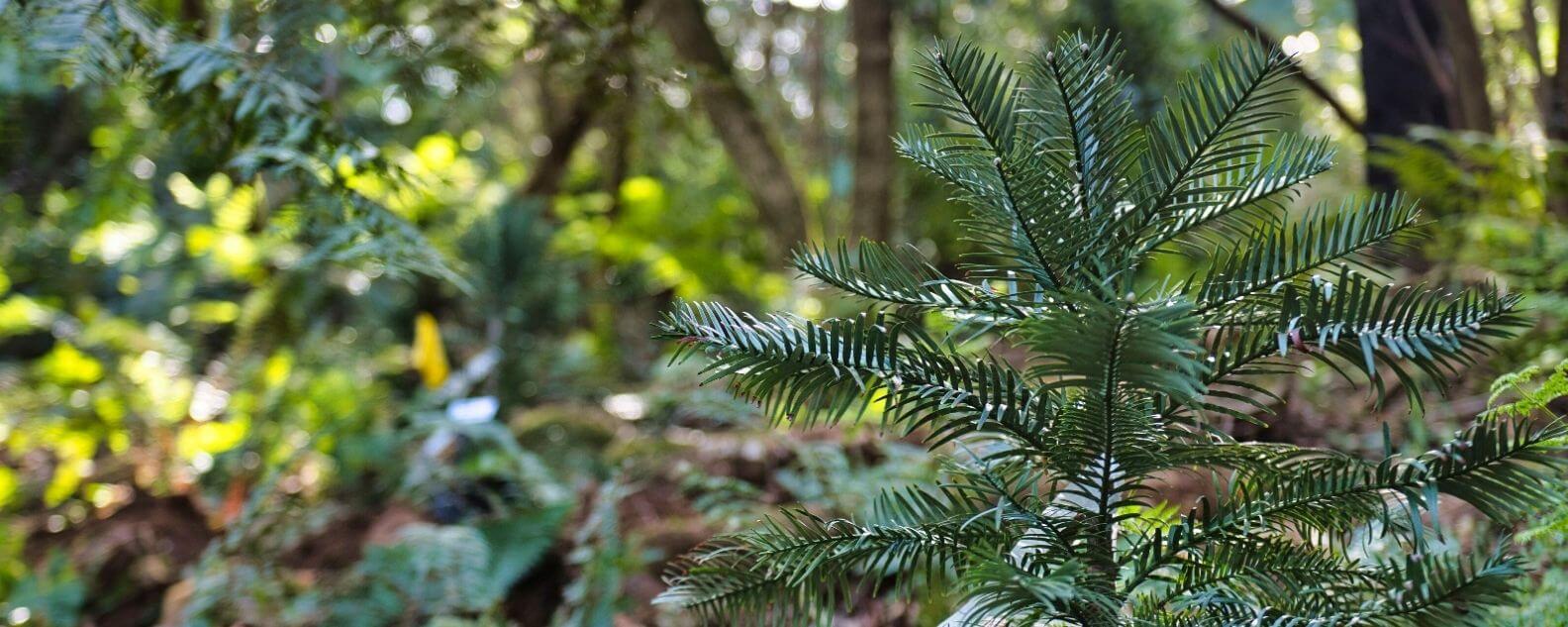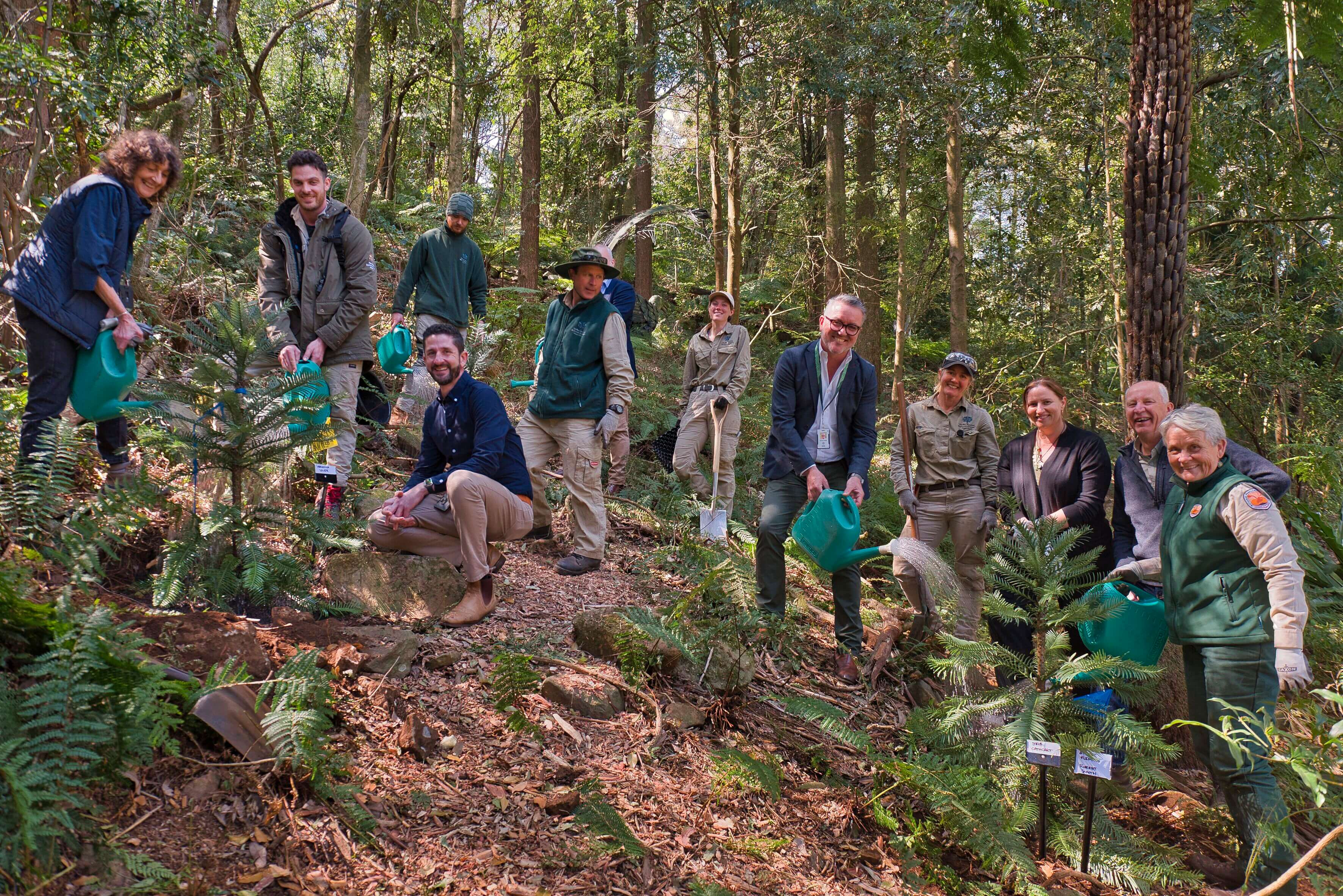30 years since historic discovery of ancient dinosaur trees
The legendary Wollemi Pine (Wollemia nobilis) has captivated the world since its discovery in the Blue Mountains in 1994. Three decades later, its survival story is not over — with the critically endangered conifer still at serious risk of extinction.

30 years of scientific research since historic discovery
A comprehensive back-up collection of Wollemi Pines – one of the world’s rarest and oldest trees - was planted at Blue Mountains Botanic Garden Mount Tomah on the 30th anniversary of its serendipitous discovery.
The special planting was not far from Wollemi National Park and the secret and secluded canyon in the Greater Blue Mountains World Heritage Area where just 46 adult trees and 43 juveniles remain in the wild.
These new seedlings will provide the most genetically diverse source of seeds for future research and conservation.
An off-duty NSW National Parks and Wildlife Services officer, David Noble was exploring Wollemi National Park in 1994 when he stumbled across these once unfamiliar giants. His chance encounter with the “living fossils” was described as the equivalent of finding a small dinosaur alive on Earth and is still hailed one of the greatest botanical discoveries of the century.
Safeguarding the ancient pine
Despite the Wollemi Pine possessing amazing survival adaptations that have allowed it to persist for millennia, it’s considered critically endangered and faces many threats in the wild. The pine’s limited geographic distribution and small population size makes it extremely vulnerable to wildfires and diseases, including the deadly Phytophthora cinnamomi, or ‘root rot’.
The site is kept top secret for a reason: unauthorised visits to the area where these ancient pines were first found risk compromising the fragile wild population and ecosystem, an Asset of Intergenerational Significance.
A highly successful conservation effort involving NSW National Parks and Wildlife Service, Botanic Gardens of Sydney, and NSW Department of Climate Change, Energy, the Environment and Water has focused on two main strategies: protection of the remaining wild population, and cultivating the pines in different locations.
Two additional populations of Wollemi Pine were established in Wollemi National Park in 2019.These populations were expanded this year with 379 saplings each, bringing the total translocated population to over 835 saplings.
As part of the insurance policy against the extinction of Wollemi Pines, scientists from Botanic Gardens of Sydney have also established a genetically diverse living collection of Wollemi Pine at the Australian Botanic Garden Mount Annan.
To back up this essential collection and provide greater resilience against the potential impacts of climate change, genetically diverse young trees were cultivated and shipped to botanic gardens across the world: to the United Kingdom, Ireland, Europe and one botanic garden in the USA last year.

A comprehensive back-up collection of Wollemi Pines has been planted at Blue Mountains Botanic Garden Mount Tomah on the 30th anniversary of its discovery.
Next chapter in the Wollemi Pine's survival story
The Mount Tomah planting is the latest chapter in the Wollemi Pine’s survival story, providing an essential local, cool-climate back up of the Mount Annan living collection.
People who have made notable contributions to the research and conservation of this remarkable species were invited to plant over 40 additional specimens, forming the most comprehensive in-ground ex situ collection anywhere in the world.
It’s hoped the collection will eventually represent as near as possible to 100 per cent of all wild specimens and will give future generations a sense of what Mr Noble must have felt as he gazed up into the canopy of these ancient trees.
“We often describe the Wollemi Pine as the poster child for conservation. These ancient trees have become a symbol of survival and hope," Botanic Gardens of Sydney Chief Executive, Simon Duffy AM.
“The special tree planting at the Blue Mountains Botanic Garden Mount Tomah and other anniversary events are about celebrating the outstanding contributions made by so many people to the science and conservation of this remarkable species.”
This planting is also one of several key objectives identified in the draft National Recovery Plan for the Wollemi Pine that will be finalised later this year.

NSW National Parks and Wildlife Services officer, David Noble, stumbled across these once unfamiliar giants while canyoning in 1994.
Forging connections with conservation
“This is the culmination of 30 years of scientific research on the Wollemi Pine. Genetically diverse plantings such as this one aim to maximise health and adaptive resilience to climate change and other pressures. I hope it will also allow visitors to form meaningful connections with plant conservation.”
“The Wollemi Pine is a botanical treasure; its discovery has not only yielded incredible scientific insights but also raised the profile of botanical science," Botanic Gardens of Sydney Chief Scientist, Professor Brett Summerell AM.
Six exclusive Wollemi Pine trees, propagated by a team of expert scientists from the original, first-generation specimens, have also been auctioned online by Foundation & Friends of the Botanic Gardens, to mark the 30th anniversary of its discovery.

People who have made notable contributions to the research and conservation of this remarkable species were invited to plant over 40 additional specimens.